IN FOCUS: The wage debate – how to lift the salaries of those earning the least?
As Singapore moves to implement the Progressive Wage Model in more sectors, CNA takes an in-depth look at how the model has benefited some workers and the challenges in expanding the scheme.
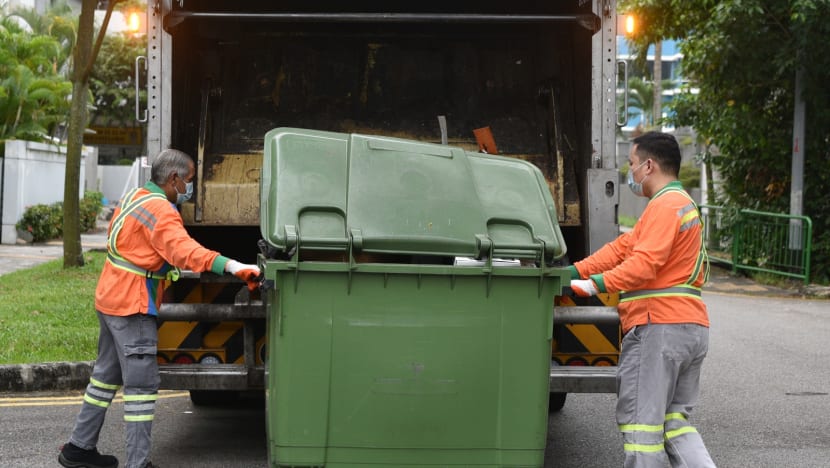
Mr Mohd Sharif Mohd Din (left) and Mr Zhang Qing Feng, SembWaste crew members on the night shift. (Photo: Jeremy Long)
SINGAPORE: As most office workers head home for the day, Mr Aziman Tohid is strapping himself into an Econic truck and checking all the moving parts of the waste collection vehicle.
With two crew members, he pulls out of SembWaste’s Bukit Merah depot to start a roughly 12-hour overnight shift clearing hundreds of rubbish bins in industrial estates.
It is hard work, and the night shift captain, tanned and spry at 56, has been doing it for 20 years. He is now in charge of more than 60 workers every night, helping them with their issues even as he does his own rounds.
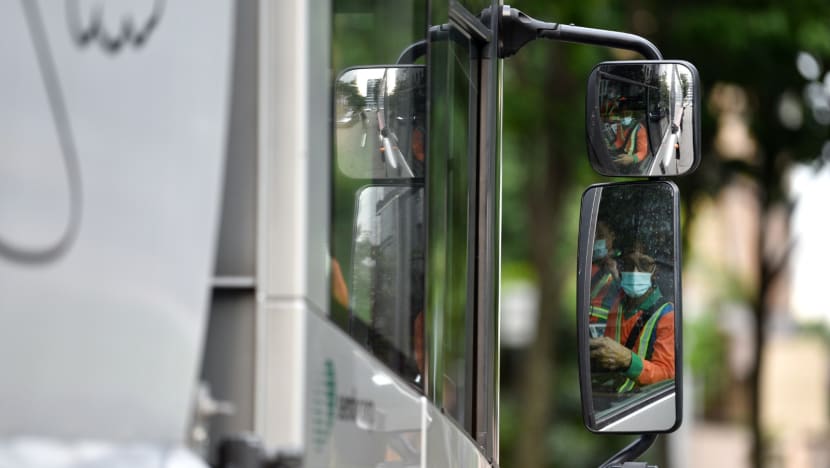
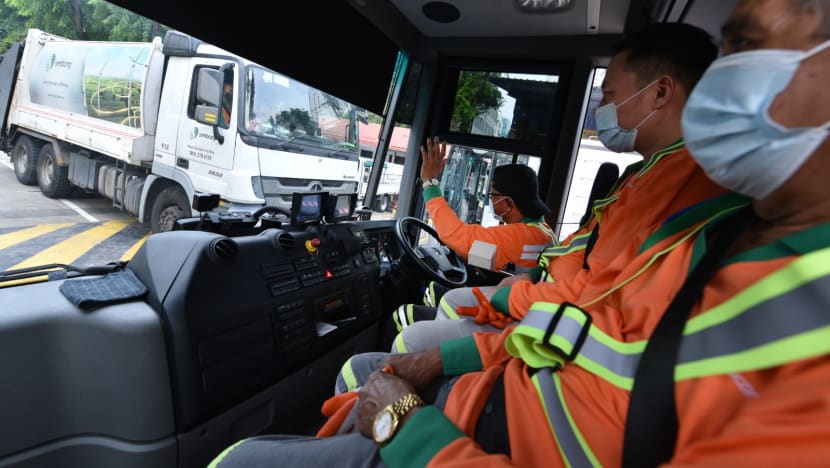
The environmental services sector has no wage standards for workers like him. But SembWaste, where Mr Aziman works, has adopted a training and wage ladder based on Singapore's Progressive Wage Model (PWM), which aims to lift workers' wages as they upgrade their skills and improve productivity.
Aziman got a 5 per cent salary increment when the system was first implemented and another 7 per cent bump when he was promoted from a Level 5 Captain to Level 6 Captain.
Mr Aziman said his pay and benefits have been “enough” for his family of 10. The clear career progression and pay scale have motivated him and his colleagues, he said.
“Actually, I didn’t expect to become a captain, but they saw what I was doing and they promoted me. (The company) appreciates what I’m doing,” he said.
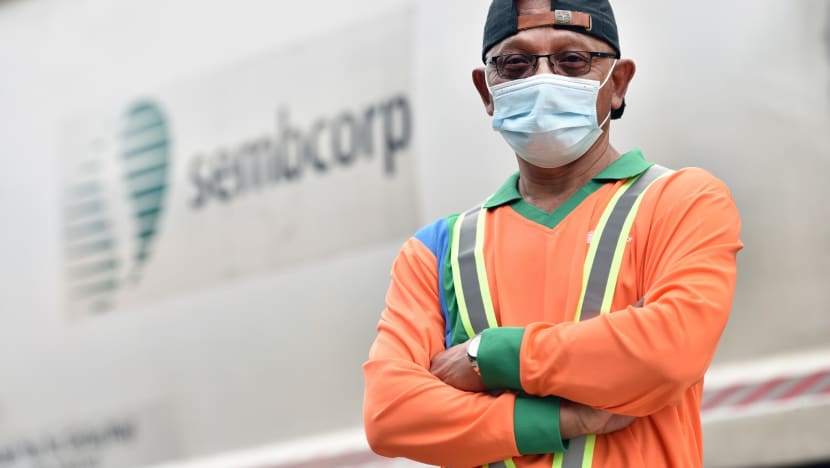
Ms Wendy Foong, Sembcorp Industries’ chief human resources officer, said that SembWaste’s PWM for its solid waste collection crew and drivers was implemented in 2015.
“(It) provides a structured and defined framework with clear career pathways pegged to training and growth incentives. We believe our people are our most critical asset,” she said.
LISTEN: Raising wages of Singapore's poorest earners: A hard look at the Progressive Wage Model
In Singapore, PWM is mandatory for the cleaning, security and landscape industries, but not for other sectors.
It returned to the limelight recently as parliamentarians debated the need for a minimum wage, and various ministers defended PWM as a better system.
Manpower Minister Josephine Teo and Senior Minister Tharman Shanmugaratnam have both referred to PWM as “minimum wage plus”, a point which union leaders echoed.
On Monday (Oct 5), Deputy Prime Minister Heng Swee Keat promised to expand PWM to more sectors over time. He reiterated that companies that voluntarily pay progressive wages to lower-income workers will be recognised with a PWM Mark – a programme first announced by Mrs Teo on Sep 1.
“We will raise skill levels, and create more and better jobs. And in time, we will slow down the future growth of the foreign workforce in these sectors,” said Mr Heng in a ministerial statement in Parliament.
“This will also mean that business costs will go up, which will add to the difficulty of businesses during this time. But COVID-19 has highlighted why it is critical, for long-term survival, for firms to be more manpower-lean, productive and have jobs that are attractive to our locals.”
MORE SECTORS TO BE COVERED BY PWM
Eight years after PWM was first introduced in the cleaning industry, it has been made mandatory for two other sectors. It now covers 79,000 low-wage resident workers – 40,000 in cleaning, 36,000 in security and 3,000 in the landscape industry.
This means that some workers pulling in lower salaries have yet to benefit from the initiative, including those in the food and beverage industry.
During the debate on the President’s Address last month, National Trade Unions Congress (NTUC) deputy secretary-general Koh Poh Koon said he hopes tripartite partners can come together to conduct an in-depth study on the implementation of PWM in more sectors.
READ: PAP MPs call for faster roll-out of progressive wage model, higher workfare payouts for essential workers
READ: Singapore’s overall unemployment rate in August climbs past global financial crisis’ high
“NTUC is continuing its conversations with tripartite partners on expanding PWM, to ensure that we have the buy-in of all stakeholders, including the Government and businesses, to implement the PWMs when the economic conditions are right,” he said.
Dr Koh, who is also Senior Minister of State for Health, told CNA that work on PWM implementation is ongoing in several sectors, with the scheme set to become mandatory for the lift and escalator sector in 2022.
NTUC is also working on expanding the PWM model in sectors like food services and this can potentially cover 50,000 workers in that sector. But for industries that are bigger and more diverse, more work is needed to assess the implications of introducing the scheme, Dr Koh said.
“For PWM to have traction, it takes time to build a strong working relationship with industry associations and relevant government agencies, which is needed to overcome possible impediments or challenges in implementing a PWM,” he said.
Explaining further why it is a drawn-out process, he said making the PWM mandatory may also require sector agencies to identify “appropriate regulatory levers” to ensure the model's scalability across the industry, and these take time to be developed and applied.
Businesses also need time to adjust human resource practices and for existing contracts of outsourced services to be completed so that new contracts take on the new manpower costs.
CHEAPSOURCING WOES
For the three sectors covered by the PWM, has it worked well? One thing to note is that all three provide outsourced services, which has led to what some called the “commoditisation” of manpower – the idea that workers are interchangeable goods.
Companies from the cleaning, security and landscape sectors told CNA that "cheapsourcing", where buyers award tenders to the lowest bidder, is a serious problem. PWM has helped to cushion the price race to the bottom, they said.
Mr Kelvin Goh, managing director of Soverus Security, said he has encountered many customers who ask for a price below the minimum at which the company has to charge in order to pay PWM wages.
“When that happens I usually just let go of the customers. The problem with the whole industry is that there are security agencies that are quoting below that minimum number … They are undercutting so much that they are definitely cutting corners because there’s only a minimum you can charge in order to pay the PWM,” he said.
READ: 'We still have some way to go': MPs emphasise individual responsibility in maintaining public hygiene standards
Mr Ang, who runs a small landscape firm, said it has been a rough ride for small companies like his over the last few months. Some customers have cancelled their maintenance services due to the COVID-19 pandemic and some of his foreign workers have had to be quarantined.
"Now, the market is very competitive, and you have to quote for the lowest price to get a contract,” said Mr Ang, who did not want to provide his full name. “If you don't, you will lose to the lowest bidder."
He has about a dozen workers, whose salaries he has to pay, he said. “If I don’t get the job ... how am I going to pay their salaries? No matter how I still need to get the job – so I bid the lowest price to secure the job."
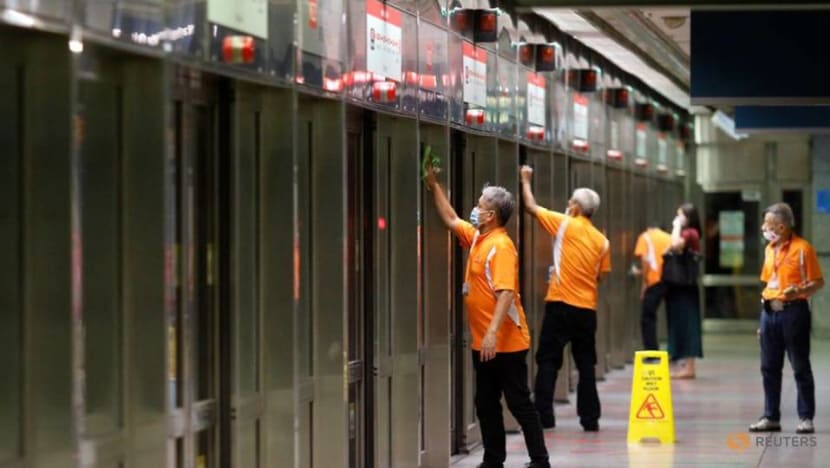
There are similar woes in the cleaning industry, companies CNA spoke to said.
The director of one cleaning company called for a minimum sum for contracts to avoid companies undercutting each other. “(Then) we will not have a low baller trying to tender very cheaply because there is no minimum wage,” she said.
FIGHTING “LOW BALLERS”
Companies that pay their workers by the rules are supportive of the PWM because they find it deters less scrupulous companies from undercutting them.
Ms Noor Irdawaty, general-secretary of the Building Construction and Timber Employees Union, said the PWM has helped to “ringfence” the wages of cleaners and landscape workers.
Prior to the PWM, the union found it difficult to negotiate with essential service providers on the wages of outsourced workers such as cleaners and landscape workers. The wages of these workers depended on the tender contract sum agreed between the companies and their clients, she said.
The PWM wage ladder acts as a “safety net” and has helped to improve their wages “tremendously”, she said.
In his speech following the President’s Address, Dr Koh called Singapore’s way of helping the workers a “triple uplift” formula of PWM, Workfare Income Supplement and National Wages Council recommendations.
Through this, the wages of the lowest 20th percentile have seen an annual growth rate of 4.4 per cent from 2014 to 2019, as compared to 2.3 per cent in the five years before.
For workers covered under the PWM, the scheme has helped to raise their wages by around 30 per cent between 2013 and 2018, he said. But they represent only about 15 per cent of all the workers in the lowest 20th percentile of salary ranges.
Even though most workers in PWM industries have seen their wages move up, some do fall through the cracks, as critics have noted.
WAGE “RESET”
Mr Tan (not his real name) tugged at his hearing aid as he asked this reporter to repeat her questions.
He has been working as a cleaner for six years but his pay remains at just above S$1,000 – it has improved over the years, but barely, and his annual leave quota has been kept at seven days.
According to Manpower Ministry regulations, employees are entitled to seven days of leave in the first year of work, after which one day of leave is added for every additional year up to 14 days. The PWM wage floor for cleaners at F&B outlets was raised to S$1,236 in July this year.
When asked if he should be paid more with his experience, Mr Tan said that every time he switches companies, he is considered a new employee. This was not always because he wanted to quit the company; when the cleaning contract changed hands recently, he chose to stay at the same premises, and so had to sign on with the new company as a newbie.
After 20 minutes reminiscing about the “good old days” while on a break, he returned to his work.
“I have a good relationship with this boss,” he said in Mandarin, adding that his children provide for him, and he simply likes working. He also receives Workfare payouts from the Government, he said.
WATCH: Are our essential workers underappreciated?
His story echoes those told to researchers in a 2018 study published in The Economic and Labour Relations Review, which looked at whether cleaning job conditions have improved in Singapore following the implementation of PWM.
The study's authors, who spoke to 21 interviewees ranging from managers to workers, found that such a practice did exist in the industry – that the employer gives yearly or shorter contracts so that workers’ leave days and wages are “reset” regularly.
This means that the PWM, for some workers, is a minimum wage but they do not get to climb up the salary ladder.
Mr Damien Huang, a research associate at the Institute of Policy Studies (IPS), told CNA that wage resetting is still a common practice.
There is also a disparity between part-time workers and full-time workers, as part-timers are covered by PWM, but it is less clear to older and less educated PWM workers how hourly wages are calculated. That is how some companies “get around” the requirements, said Mr Huang.
He suggested that the Government consider publishing the hourly wage rates for PWM occupations, which could also serve as a guide for other sectors.
Mr Huang thinks that a universal wage floor can be a complement to PWM, and it would cover workers in industries that fall through the cracks. He suggested regular increases can be pegged to inflation, for example, and this would be faster and easier to implement than PWM.
Some workers may have been “stuck with a low salary” for years, as negotiations drag on, he added.
This was a point that the Workers’ Party touched on in its proposals for a minimum wage in Singapore. According to the party's manifesto for the 2020 General Election, there were 100,000 Singaporeans who earn a take-home pay of less than S$1,300 while working full-time.
PWM VS MINIMUM WAGE
Even as some laud the benefits of the PWM, discussions continue about whether a universal minimum wage might have its own advantages.
In Parliament last month, Workers' Party MP Jamus Lim recommended a “simple, across-the-board" minimum wage. Following his speech, made in response to the President's Address, he was questioned by six MPs from the ruling People’s Action Party, including Mr Tharman. They challenged him on the efficacy of a minimum wage, as well as the timing and appropriate figure.
Dr Koh said NTUC understands the calls for all Singaporeans to earn a decent minimum wage and takes no “philosophical stand” on the issue. However, PWM encourages workers to up-skill and upgrade themselves, he said.
“A minimum wage would not be as nuanced ... A minimum wage is fixed while PWM has a salary, skills and job scope progression mapped out. It allows workers to gain the dignity of earning a decent wage and the pride of career progression.”
He added it would be a challenge to find a minimum wage that is suitable across industries.
“A one-size-fits-all minimum wage would mean that low-wage jobs in certain sectors get an uplift while constraining those in other sectors which can have a potentially faster wage growth,” he said.
“Therefore, where possible, we should implement PWM and perhaps use occupational or sectoral wage benchmarks for the sectors where it is more difficult to implement PWM.”
READ: Tharman, PAP MPs debate minimum wage, policymaking with WP's Jamus Lim
While there is no minimum wage in Singapore, the National Wages Council has recommended a “basic wage threshold” which it raised to S$1,400 in guidelines issued in May last year.
It also recommended employers increase wages by S$50 to S$70 for low-wage workers earning a basic monthly wage of up to S$1,400, and employers that achieved productivity gains give a bonus of S$200 to S$360 to such workers.
Mr Steve Tan, executive secretary of the Union for Security Employees, said there are many similarities, but PWM is “more sustainable”.
PWM for the security sector was launched in 2016 and it was made a licensing requirement for all security companies. The basic wage for an entry-level security officer is currently set at S$1,250. Their gross wages are now about S$2,100 to S$2,200, said Mr Tan.
Under PWM, there have been two annual wage increases of S$75 since 2019, and next year, the wage hike will be S$150. The higher increase is because the industry will start to cap overtime hours so that officers will not be overworked.
WAGE POINT VS WAGE LADDER
“Minimum wage in its purest form is a wage point – it needs to be negotiated every year. It’s not sustainable ... because sooner or later, five years down the road, we’ll run out of excuses (to raise wages),” said the unionist, who was involved in the implementation of PWM in the security industry.
Explaining why PWM has a wage ladder and training requirements, he said training boosts productivity, improves professionalism and helps to convince the buyers to pay more for the officers’ services.
“When we were involved in the tripartite discussions, the buyers literally bay for blood. You ask them to pay S$50 more, they’ll ask you – same (security) uncle before and after? Why should I pay you S$50 more?” he said, recounting anecdotes of the resistance they encountered each time the industry tried to raise wages.
PWM establishes standards for what the skills and certifications the officers should have, as well as ranges for annual increments, Mr Tan said.
“I think productivity is the missing delta in the conversation … the end has to be sustainable wage increase, and the wage increase can only be sustainable if is driven by productivity,” he said. “(PWM) is definitely far superior to us quibbling over a wage point.”
But he went on to say that PWM can only take the industry so far.
“It is a means to an end. What do we want to do? We want our sector for security to be a career of choice,” he said. If that was the case, then the industry should aim to pay a wage level similar to Singapore’s median wage, which in 2019 was S$4,563, he proposed.
READ: Income growth slows in Singapore; median salary now above S$4,500: MOM report
“With that in mind, the critical question becomes not what the amount should be annually. It should be what work should the officer be doing to earn S$4,600?” he said, as he listed examples from other countries on how using technology and redesigning security officers’ job scopes can help them get there.
THE FOREIGN WORKER FACTOR
Some economists told CNA that higher wages would also motivate firms to upgrade workers and improve productivity using more efficient methods.
Professor Hui Weng Tat, an expert on labour market policies in Singapore, said that if there are workers receiving much lower wages in sectors not covered by the PWM, employers in PWM sectors may be reluctant to provide training. Instead, they can source for cheaper employees at entry-level wages.
“Why limit PWM to only a few sectors? Make it economy-wide – have a minimum wage scheme,” said Prof Hui, who is the dean of Nazarbayev University's Graduate School of Public Policy in Kazakhstan.
Labour economists such as Associate Professor Walter Theseira pointed out that the relationship between productivity and skills is not always straightforward.
He gave the example of teachers, who do not teach more students compared to 50 years ago, but their “value-add” has changed tremendously because the value of education has gone up over time.
“In reality for many jobs, value-add goes up over time for reasons that are not directly connected to higher physical output … Sooner or later, PWM must confront diminishing improvements to physical productivity. And at that point we must accept that wage increases have to come from other sources,” said Assoc Prof Theseira, who is from the Singapore University of Social Sciences.
READ: MPs call for firms to be more transparent on foreign hiring, make push to prioritise Singaporeans
He also pointed out that there are social costs to cheap labour that the market does not recognise.
“That social cost basically comes from the fact that low-wage workers often don't have enough income to support themselves and their families and the difference is made up with support from the public,” he said.
The interactions between prices, wages, productivity, employment rate and social costs are not that clear-cut, and the net positives or negatives of a policy can be difficult to assess.
What Assoc Prof Theseira and other economists agreed on was this: The inflow of foreign workers has depressed wages for low-wage workers, and measures are needed to protect them.
“Their dominant presence makes the poor wages and conditions extremely difficult for locals to accept. Therefore, the magnitude, wages and job conditions of migrant workers also need to be addressed as part of the solution.
“The overarching issue is wages and conditions of low-skilled jobs, for both Singaporeans and migrant workers,” said Associate Professor Irene Ng, lead author of the 2018 study on PWM.
FOREIGN WORKER QUOTAS
One way Singaporean workers are shielded is through a quota for work permit and S Pass holders, which requires companies to hire Singaporeans or permanent residents (PRs) in order to hire foreigners on such permits.
In the cleaning industry, which is under the services sector, the Dependency Ratio Ceiling is 38 per cent – which means a firm has to hire about four Singaporeans to be able to hire two foreigners. This ratio has been gradually lowered over the years in favour of resident workers, and will be further lowered to 35 per cent next year.
There were 687,600 work permit holders, excluding foreign domestic workers, as of June this year – a drop from the more than 730,000 last year, partly due to COVID-19.
One cleaning company told CNA that they pay their local workers a minimum of S$1,400 a month as that is the qualifying salary to count them as full-time workers – and so allows the firm to hire more foreign workers.
Under the Dependency Ratio Ceiling, a Singaporean or PR is counted as one local employee if they earn at least S$1,400 per month, but as half an employee if they earn between S$700 and S$1,400.
READ: Budget 2019: Foreign worker quota in services sector to be cut to 35% by 2021
“(The) competition effect pushes local wages down, while being able to hire more foreign workers provides a strong incentive to pay what is necessary to get another Singaporean onto the job,” said Assoc Prof Theseira.
Having fewer foreign workers would increase pressure on companies to raise the wages of its lower-paid workers, he added.
What about the fact that few Singaporeans want to take on jobs like cleaning toilets and clearing rubbish? Mr Huang said that besides paying them more to do the tougher jobs, there is also a need to change the stereotypes associated with such jobs.
“Workers who have to work in the sun, or have to do physically demanding or ‘unpleasant’ jobs, can get a wage premium compared to office workers, who have a nice, comfortable seat in an air-conditioned office,” he said.
But companies, unionists and most experts maintained that a foreign workforce is needed to complement local workers in these industries, although they disagreed on the ratio and other details.
Said NTUC’s Dr Koh: “The current quota system for work permit and S Pass holders, coupled with our PWM, uplifts the wages of low-wage workers while ensuring a complementary foreign workforce to augment our local labour force.”
A LIVING WAGE AND WORKFARE
Ultimately, everyone CNA spoke to agreed that better wages, higher productivity and better working conditions, with as little unemployment as possible for these workers, was the desired outcome. The differences were over how to get there and what some of the trade-offs should be.
Said Assoc Prof Theseira: “Basically, the question of minimum wages really should not be separated from questions about standards of living and the structure of the labour market.
“I think we need to ask: What is the standard of living that we think working Singaporeans should be able to achieve, including not just subsistence, but also, decent quality housing, opportunities to start and develop a family, and to retire?”
With that figure, Singapore can then focus on the jobs that do not allow people to achieve that – due to low wages or other factors, he said.
“What is wrong about those jobs or industries that make it impossible for working Singaporeans to achieve those objectives?” he asked.
READ: Foreigners keep Singapore ‘economically relevant’, but pay attention to the Singapore worker: Pritam Singh
For instance, the entry-level wage for the security officer is S$1,250, which is about 27 per cent of the median wage. In most developed countries, minimum wages are set at between 40 and 60 per cent of the median wage, said Prof Hui.
A household budget study in 2019 estimated that an elderly person living alone needed S$1,379 a month to achieve a basic standard of living, and a couple living together needed S$2,351.
While this is higher than the lowest wage rungs of PWM wages, the picture is more complicated. Several cleaners the reporter spoke to had other means of support, including Workfare, Central Provident Fund (CPF) payouts and allowances from their family members.
Workfare is given to Singapore citizens who are 35 years or older and earn a gross monthly income of not more than S$2,300. Payouts are tiered such that the lower the worker’s income and the older the worker is, the more they get.
A worker aged 60 and above can get up to S$4,000 in payouts a year, of which 40 per cent is in cash and the rest in CPF contributions.
Dr Koh said that Workfare uplifts workers earning less than S$2,300 a month in industries not covered by PWM, without imposing burdens on the companies, while allowing society to help the more vulnerable through their tax dollars.
WILL CONSUMERS PAY MORE?
Assoc Prof Ng, who is from the National University of Singapore’s Social Work Department and Social Service Research Centre, said that the Workfare Income Supplement is a variation of a universal basic income.
“Workfare incentivises employers to hire low-wage older workers by subsidising employers," she said. With a higher proportion given as CPF payouts rather than cash, the scheme also helps supplement these workers' retirement needs, she added.
Commentary: A minimum wage isn’t the answer to inequality
Dr Chew Soon Beng, a professor of economics and industrial relations, told CNA that the way to protect local workers was neither minimum wage nor PWM, but Workfare, as a minimum wage could lead to unemployment and other unintended effects.
His argument was that the wages of low-wage workers will increase when Singapore’s economy does well, and wages will continue to improve if the economy continues to move up the value chain.
“When the economy maximises wages, it must reduce employment … If we can benefit from having lots of foreign workers for the whole country and protect our low-wage workers based on Workfare, we should use Workfare,” he said.
He added: “If we do not want foreign workers, residents must pay more for essential services. If we want our foreign workers to live with social distancing, we have to pay more for essential services.”
READ: GE2020: Tharman assures that Singapore wants to provide better jobs over time
Dr Koh said he hopes service buyers will price contracts fairly, and award contracts based on performance and quality, so that workers can be paid fair wages. The Government, for instance, is committing to have most agencies adopt outcome-based security contracts by this year.
“As consumers, we must also take an honest look at the prices we are paying for our services. We must be willing to accept that prices may increase if we want to ensure that workers are paid more.
"When consumers are prepared to pay fair wages for our workers, this will provide a genuine, market-driven uplift to the wages,” said Dr Koh.















